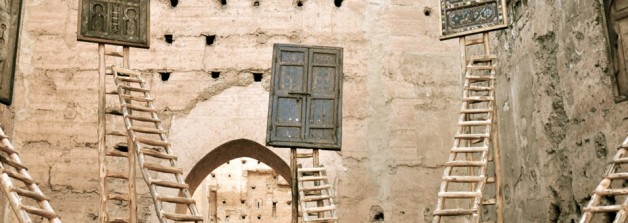MARRAKECH BIENNALE 6
Green Olive Arts is proud to share a new press release from the organizers of the 6th edition of the Marrakech Biennale, scheduled to open February 24th 2016

Press Release – 10 OCTOBER 2015 – “Not New Now”
Curated by Reem Fadda, the 6th edition of the Marrakech Biennale announces its curatorial concept …
Abstraction | Action art | Africa | Arab world | Civic Awareness | Cultural Resistance | Decolonization | Defeat | Ecology| Folklore | Junk art | Materiality | Minimalism | New | Now | Play | Recycling | Responsibility | Responsiveness | Survival Technologies | Urgency

Khaled Malas – Windmill
Not New Now
How do we surpass the cultural orientation towards newness? That same culture inherited from the modern ideal, which in thinking advancement, has caused for hollow consumption. The postmodern order recycled the past and packaged it in the mere service of the new. Then, is the search for the New, with its inherent aspirations for discovery and truth, a mere escapism? Could we simply reject the New?
We are caught in a temporal Ping-Pong that oscillates between future and past, seemingly disregarding the present. For if the New, as a cultural and material trope, is bound to the future, and history is anchored to the past, how and when are we left to emphasize the now? Could the surmounting political urgencies, the tremors of earth—that growing wasteland, the vestiges of materials, bones, and boats in shores and art alike—, the calls for responsibility and ecology all be heard beckoning for this shift of time focus? This is the time for a heightened civic awareness, focusing on action and responsiveness.
Marrakech is Africa and the Arab world; they are throbbing all at once. The city lends itself as a site, bare of white walls, to look at art from within the larger continent. Through the biennale, we will examine how art is used formally, as a means for cultural resistance, and how ideas, ranging from abstraction, minimalism, recycling, junk art to creative survival technologies, are becoming pervasive from past present experiences that occurred there. The biennale looks at the legacies of decolonization, in addition to its failures, as one of the origins that has inspired contemporary art to embrace incendiarism, criticality and radicalism. The biennale’s premise also builds on the intangible, a longstanding history of Pan Afro- Arab & Afro-Asian unity, through critically investigating socio-political projects, cultural partnerships, intellectual provocations and art movements that have led to many shared artistic tendencies.
Public heritage sites of Marrakech, such as Palais El Badi and Palais Bahia, will witness a variety of works from installations to site-specific commissions, by a group of international artists, focusing on Africa, the Arab world, and its Diasporas. Performances, exhibitions of archives, film programs, seminars, lectures, and even conferences will provide for an art structure that looks at and interrogates these cultural commonalities and interlaced relationships.
The Marrakech Biennale 6 will consist of the main exhibition curated by Reem Fadda and assistant curator Ilaria Conti. It will also include interjections by collaborating curators, Omar Berrada, Salma Lahlou and Fatima-Zahra Lakrissa. Simultaneously, a selection of Partner and Parallel Projects will also be on view across various parts of the city.
About the Marrakech Biennale
Founded in 2004 by cultural entrepreneur Vanessa Branson to address social issues through the arts, the Marrakech Biennale has become a celebration of creativity in a city that has for centuries been the focus of artistic investigations. An internationally recognized event, the Biennale features a thriving interdisciplinary art program.
The artistic committee composed of Jamal Abdenasser, M’barek Bouhchichi, Hicham Lahlou, Sandrine Dole, Estelle Guillé, Khalid, Tmaer Amine Kabbaj and Reem Fadda met in Marrakech 18-19 September.
More than 300 applications had been submitted from over 50 different countries and four continents. By evaluating the quality of proposals and their consistency with the curatorial project, the committee selected 30 parallel projects.
Among the selected projects there was a predominance of visual arts projects with 24 proposals, including 9 videos, 9 installations and 4 photography projects. Another 6 performing arts projects and 10 projects for the Art in public space was selected.
The selection also reflects the Committee’s wish to open the biennale to new creations in particular from Africa, the Arab World and their diasporas. This is noticeable in the choice of creations in situ; multidisciplinary projects and projects led by young artists including several Arab-African, among which several Moroccan projects.
The official and final list of selected parallel projects will be available on our website at the end of October.
For the first time, the 2016 Biennale will present its program in public spaces and free of charge, in an effort to welcome a wider public and reinforce the Biennale’s connection to Marrakech’s urban historical landscape. Another step in opening the Biennale to a wider public is the new collaboration with the International Meetings of Art in Public Places Awaln’art, through which the program in public spaces will be intensified.
The Biennale will also be in view for the first time over a prolonged period of 11 weeks. Each week the Biennale will present a diverse program of artist talks, performances, and symposiums.
Executive President: Amine Kabbaj
President of Supporting Committee: Aziz Mekouar Honorary President: Mr. André Azoulay
Press contact
Pascale Hervy: pascale.hervy@marrakechbiennale.org
*Download the press release PDF here
NOTE: Green Olive Arts will be hosting a special curated residency called CONVERGENCE 2016 in Tetouan, Morocco, where a select group of art practitioners will gather to explore where the streams of heritage, history, art and culture come together in the Moroccan city. The residency will conclude with a trip to the Marrakech Biennale opening events. Application deadline 30-October-2015.

